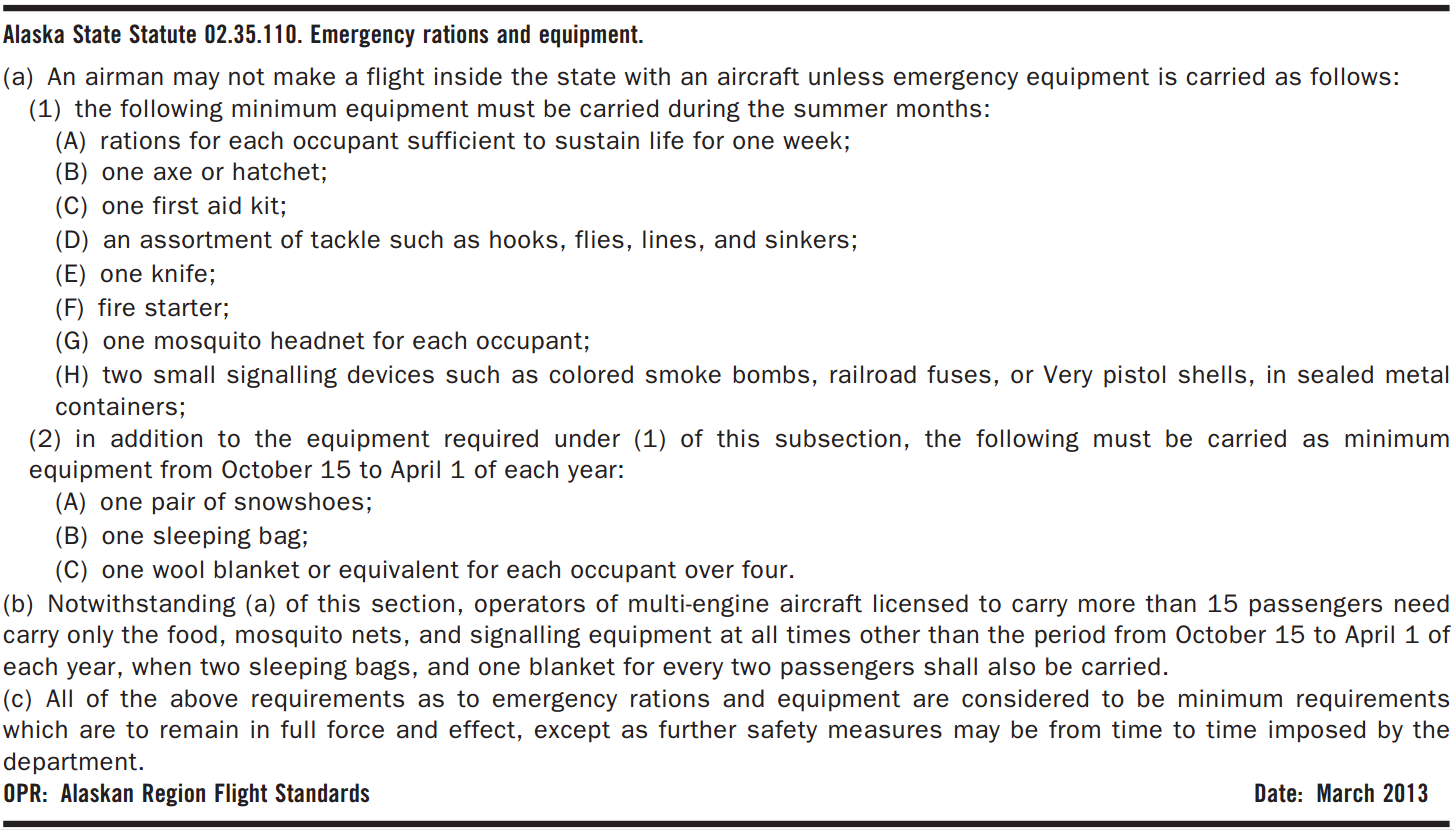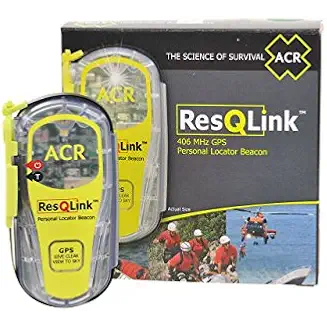Flight Hazards & Safety
Flight hazards can manifest themselves in many different forms, including environmental, man-made, and mechanical.
Introduction
Introduction
- Emergency equipment is your life-line when stranded until Search and Rescue (SAR) arrives
Emergency Equipment
Emergency Equipment
- Each item must be inspected in accordance with 91.409 to ensure its continued serviceability and immediate readiness for its intended purpose
- Must be readily accessible to the crew
- Must clearly indicate its method of operation
- When carried in a compartment or container, must have that compartment or container marked as to its contents and last date of inspection
- Hand fire extinguishers must be provided for use by the crew, passenger, and cargo compartments in accordance with:
- Type and quantity must be suitable for the kinds of fires that may occur
- Must be properly secured so as not to interfere with safe operation of the aircraft but still identified and accessible
- At least one extinguisher must be on or near the flight deck
- At least one extinguisher must be located in the passenger compartment:
- 1 for every 6-30 passengers
- 2 for 30+ passengers
- See also, InFO 18013
- First aid kids for treatment of injuries likely to occur in flight
- Crash axe if more than 19 passengers
- Each passenger-carrying airplane must have a portable battery-powered megaphone readily accessible to the crew to direct evacuation:
- 1 for airplanes with a seating capacity of 60-99 generally installed in the most rearward location
- 2 for airplanes with a seating capacity of 100 or more, installed in the most forward and rearward location
Emergency Locator Transmitter
Emergency Locator Transmitter
- Emit a distinctive audio tone on 121.5 MHz (VHF) and 243.0 MHz (UHF)
- ELTs operate continuously for at least 48 hours over a wide range of temperatures
- ELT batteries must be replaced or recharged if the battery is rechargeable one-half of its useful life or if used for more than one cumulative hour
- ELTs may be tested 5 min after the hour
- Must be in accordance with FAR 91.207 / AIM 6-2-5
- Find more on the emergency locator transmitter page
Factors to Consider
Factors to Consider
- Type of terrain or surface
- Type of climate and temperature conditions expected
- Type of emergency communications needed
- Location in the airplane
- How to operate or use
Basic Survival Gear
Basic Survival Gear
- First aid [Amazon]
- Flashlight [Amazon]
- Rescue Light [Amazon]
- Water
- Knife/multi-tool [Amazon]
- Matches (waterproof) [Amazon]
- Life Vests [Amazon]/Life Raft
- Additional clothing/warming layers
- Personal locator beacon
- Lighter/fire starter
- Glow stick [Amazon]
- Sunburn cream
- Bug repellent
- Snakebite kit
- Compass
- Signal mirror
- Warming pouches
- Whistle
- Water/camelback
- Non-perishable food
- Space blankets
- Nylon chord
- Two-way hand-held radios [Amazon] and cell phone (depending on expected coverage)
- Batteries
- Survival Equipment for over water operations (91.509)
- Phone/device charger
- GPS messanger
- Water bottle/container
- Water purification items
- Food stuffs with high caloric value, like protein bars
Flotation Gear
Flotation Gear
- Aircraft operating beyond power-off glide distance from shore are required to have access to flotation equipment [Amazon]
Signaling Devices
Signaling Devices
- Signaling devices [Amazon] are required for VFR flight over water but can be equally as important if you ever become stranded in a remote area on land
Ballistic Parachute Systems
Ballistic Parachute Systems
- Ballistic parachute systems (BRS) are designed to safely return an aircraft to the ground in the event of an emergency, such as engine failure, structural damage, or other hazards that might lead to a crash
- BRS systems can be installed in smaller aircraft and helicopters
- Ballastic Parachute Systems Maintenance:
- BRS' require maintenance performed by a trained aircraft mechanic
- Mechanics are looking for signs of wear, corrosion, damage or other items as specified by the manufacturer
- Inspections and some part replacements are required on a schedule or as required (suspected damage, inadvertant activation, etc.)
- Pilots must pay attention to these inspection and replacement intervals as part of their preflight
- Major maintenance such as repacking or following any breach of the inner or upper cap of the cannister require factory attention
Emergency Auto-land Systems
Emergency Auto-land Systems
Winter Considerations
Winter Considerations
- Wear or have available layers of clothing
- Wear or have available boots or wet resistant footwear
- Continue to hydrate, even if not sweating
- Have blankets or tarps that can be used to create shelters or limit exposure from elements
Things to Remember
Things to Remember
- More than one emergency at once can and has happened
- Filing a flight plan causes SAR after you have failed to arrive at your destination and no contact has been established
- Be sure the ELT has activated as it may not active from the crash
- Use parts from the aircraft for survival gear
- Common sense, "You are the most important survival tool on board"
- Extended over water operations (135.167)
- Survival Equipment (AIM 6-2-7h)
- Last but not least, be creative
- You may not think you have much, but you brought a ~2,000-pound suitcase
- Use what you must, seats, fuel, compass, radio, your maps
Emergency Equipment Preflight Briefing
Emergency Equipment Preflight Briefing
- Brief passengers on all emergency equipment present and how to use it
Private Pilot (Airplane) Emergency Equipment and Survival Gear Airman Certification Standards
Private Pilot (Airplane) Emergency Equipment and Survival Gear Airman Certification Standards
- Objective: To determine whether the applicant exhibits satisfactory knowledge, risk management, and skills associated with emergency equipment, and survival gear appropriate to the airplane and environment encountered during flight
- Note: See Appendix 3: Aircraft, Equipment, and Operational Requirements & Limitations for information related to this Task
- References: FAA-H-8083-2 (Risk Management Handbook), FAA-H-8083-3 (Airplane Flying Handbook), FAA-H-8083-25 (Pilot Handbook of Aeronautical Knowledge); POH/AFM
Private Pilot (Airplane) Emergency Equipment and Survival Gear Knowledge:
The applicant demonstrates an understanding of:-
PA.IX.D.K1:
Emergency Locator Transmitter (ELT) operations, limitations, and testing requirements. -
PA.IX.D.K2:
Fire extinguisher operations and limitations. -
PA.IX.D.K3:
Emergency equipment and survival gear needed for:-
PA.IX.D.K3a:
Climate extremes (hot/cold). -
PA.IX.D.K3b:
Mountainous terrain. -
PA.IX.D.K3c:
Overwater operations.
-
-
PA.IX.D.K4:
When to deploy a ballistic parachute and associated passenger briefings, if equipped. -
PA.IX.D.K5:
When to activate an emergency auto-land system and brief passengers, if equipped.
Private Pilot (Airplane) Emergency Equipment and Survival Gear Risk Management:
The applicant is able to identify, assess, and mitigate risks associated with:-
PA.IX.D.R1:
Survival gear (water, clothing, shelter) for 48 to 72 hours. -
PA.IX.D.R2:
Use of a ballistic parachute system. -
PA.IX.D.R3:
Use of an emergency auto-land system, if installed.
Private Pilot (Airplane) Emergency Equipment and Survival Gear Skills:
The applicant exhibits the skills to:-
PA.IX.D.S1:
Identify appropriate equipment and personal gear. -
PA.IX.D.S2:
Brief passengers on proper use of on-board emergency equipment and survival gear. -
PA.IX.D.S3:
Simulate ballistic parachute deployment procedures, if equipped.
Conclusion
Conclusion
- According to the National Search and Rescue Plan, "The life expectancy of an injured survivor decreases as much as 80% during the first 24 hours, while the chances of survival of uninjured survivors rapidly diminish after the first 3 days"
- An Air Force Review of 325 SAR missions conducted during a 23-month period revealed that "Time works against people who experience distress but are not on a flight plan, since 36 hours normally pass before family concern initiates an (alert)"
- Consider the type of flying you are doing and think about investing in a Aviation Crash Kit [Amazon], just in case
- Remember to incorporate the weight of survival equipment when completing the aircraft's weight and balance
- Check out AOPA's Survive: Beyond the Forced Landing course for more information
- Although not emergency equipment, pilots should consider wearing closed-toed shoes, long pants, sleeved shirts with conventional fabrics, and carrying a jacket or sweatshirt when appropriate - considering overnight temperatures - to protect the pilot in the event of a ditch
- Consider reviewing the AOPA's Survival Safety Resources
- Still looking for something? Continue searching:
References
References
- Federal Aviation Administration - Mastering Ballistic Parachute Systems Maintenance
- Federal Aviation Administration - Pilot/Controller Glossary
- Federal Aviation Regulations (91.409) Inspections
- Federal Aviation Regulations (91.513) Emergency Equipment
- Federal Aviation Regulations (91.509) Survival equipment for over-water operations
- CFI Notebook.net - Emergency Transmitter Locator (ELT)
- CFI Notebook.net - Search and Rescue
- FAA - General Aviation Survival
- OPNAVINST 3710.7U (7.1.1.2) Life rafts
- OPNAVINST 3710.7U (8.2.2) Life rafts
- Pilot Workshops - Survival Gear






